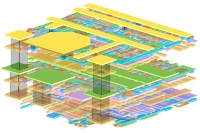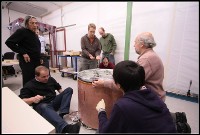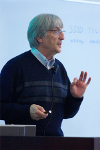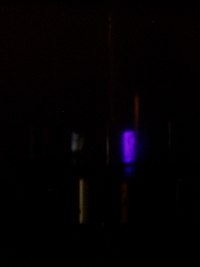 |
|
|
 |
Pixel collaboration
R&D on monolithic and vertically integrated pixel detectors

Micro Magic 3D-layout of the 3-tier Fermilab Vertical Integrated Pixel (VIP) chip. |
Plans are taking shape to form a new group to coordinate and stimulate R&D on monolithic and vertically integrated pixel detectors for scientific applications in high-energy physics and beyond. In a joint message, the directorates of CERN, KEK and Fermilab have offered their support. They suggested the formation of a regionally balanced coordination board to take this forward. From discussions in recent reviews and workshops, we think there is an opportunity for the many efforts underway worldwide to benefit a larger community. We already have strong collaborations for the development of vertical integration and monolithic active pixel sensors (MAPS). The new world-wide effort would build upon the existing collaborations and open the technology developments to other scientific areas. We will discuss how best to achieve this at upcoming meetings. Our suggestions will then be comunicated to the directorates of CERN, KEK and Fermilab.
Read more...
-- Chris Damerell (Rutherford Appleton Lab), Marcel Demarteau (Fermilab) and Yasuhiro Sugimoto (KEK) |
 |
|
|
 |
|
 |
Under pressure
Large time projection chamber prototype is about to start its first test

TPC collaborators from across the globe fit the endcap onto the TPC field cage. |
The time projection chamber is part of the tracker system of a future ILD detector at the ILC and will one day reproduce highly precise tracks of the particles that passed through its gas. A plot of all the tracks leading to a workshop called ‘the tent’ on the DESY campus would make for an interesting event display: in the course of the last weeks many parts for the detector prototype arrived from destinations around the world, together with their experts. While field cage, cathode and module dummies came from Germany, the anode endplate travelled all the way from Cornell University in the States. France brought a Micromegas readout module, Belgium contributed the trigger logic and the Netherlands the beam trigger equipment for the coming test with cosmic rays or test beam.
Read more...
-- Barbara Warmbein |
 |
|
|
 |
From Wall Street Journal
11 November 2008
Mining for Dark Matter, Some Go Wimp-Hunting
The Exotic Particles Would Explain a Lot About the Universe, and That Promise Has Scientists Going Underground
Read more... |
|
From Scientific American
10 November 2008
New Theories May Shed Light on Dark Matter
The stuff of mystery may be more than meets the eye
Read more... |
|
From UPI.com
10 November 2008
The search for dark matter might soon end
A German-led consortium of scientists says the search for the mysterious substance known as dark matter could soon end.
Read more... |
|
From symmetry breaking
10 November 2008
3-D printer puts detector at your fingertips
...He and SLAC’s Norman Graf stack the pieces together like oversized Legos and voilà! A 3-D version of the detector that can be displayed to scientists, engineers and other project members to help them better understand the massive detector they are trying to build.
Read more... |
|
|
 |
 |
|
|
 |
Formalising the CLIC-ILC collaboration

Jean-Pierre Delahaye, CERN CLIC study leader |
Collaboration between our ILC R&D and design work and the parallel effort towards the CLIC concept stands to be of benefit to both groups. This direction also promises to help break down barriers between the two groups, making the worldwide effort towards a linear collider more integrated and unified. Of course, the underlying concepts are fundamentally different and affect much of the rest of the design: for acceleration in the main linac, the ILC uses superconducting RF, whereas CLIC accelerates through a drive beam. Nevertheless, there is a great deal of mutual interest in other areas and we have formed five working groups that are already well underway and two more working groups are being set up. We have now taken the step to formalise the mode of our collaboration, especially regarding guidelines for communication outside the collaboration. This will help enable the joint work to go forward and be used in ways agreeable to both groups.
Read more...
-- Barry Barish
Director's Corner Archive |
 |
|
|
 |
What is it?

It's not an aurora borealis, it's not a blurry christmas tree... but what is it?
Send us your guesses or tell us next week at LCWS/ILC08!
|
 |
|
|
 |
Entries for the calendar?
Is your meeting featured in the ILC Calendar? Are enough people registering for your symposium? Is that important conference on your agenda? We are happy to include your entries
in the ILC Calendar -- just send title, place, time and link to communicators@linearcollider.org!
Announcing ARW 09
We are happy to announce that the second
Accelerator Reliability Workshop
will be hosted by TRIUMF in the scenic city of Vancouver, B.C., Canada, 26 to 30 January 2009.
The workshop will feature talks, poster presentations and open discussions on the reliability of hardware,
software and humanware in the accelerator world. Spread the word to all who might be interested to bring
their accelerator reliability related problems and solutions to the discussion table.
I look forward to welcoming you in Vancouver,
Violeta Toma, chair ARW 2009
|
|

